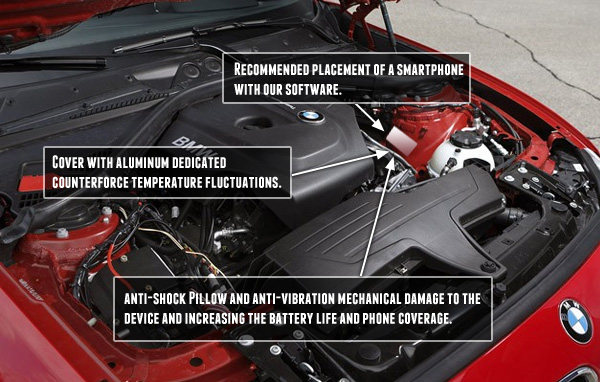
BMW 1 SERIES E88 GPS Tracking
Track your 1 SERIES E88 for free and visualize it on map
Produced to: NOW
How to track your favourite BMW - model 1 SERIES E88 in realtime for free ?
Producer remarks about this particular model
SERIES 1 represents the smallest compact cars with rear-wheel drive. Used system - efficient dynamics – allows to increase in power while reducing fuel consumption. Recently produced in four body types and seven engine versions.Our product description
We are offering you completely free of charge our GPS car tracking solution in real time. The only thing you need to do is to install smartphone with Android inside your vehicle with our awesome application on board
If you want to track your BMW 1 SERIES E88 in real time you have to do the following :
1. Download Free Car Tracking Application for 1 SERIES E88 application from Google Play
2. Create free account on spysat.eu (for example johndoe) - here is detailed instruction
3. Define Device endpoint for each vehicle you want to track - give friendly name of your 1 SERIES E88 and PIN (some random will be provided - you can change it if you want)
4. Run SpySat mobile application on the smartphone and type there your LOGIN from SpySat (ex. johndoe) and PIN (from point 3.)
5. Install your smartphone inside the car
6. Enjoy watching position of your car at spysat.eu site.
7. Provide stable power supply - spysat app consumes some energy.
Best options to install smartphone inside BMW 1 SERIES E88

Our designers in collaboration with the BMW engineers have developed an optimal system namierzaj±cego unit is placed in the engine. Based on the settings of the various parts of the engine, it was found that the optimal setting of the device software Car Track is have any of 30 cm from the battery.
Enclosure provides protection against mechanical shock and damage caused by temperature changes. A set of anti-vibration sponge thoroughly protect the device.
To permanently mount a smartphone in your BMW 1 Series E88, you'll need to follow these steps:1. First, make sure your phone is waterproof and has a rugged design to protect it from any potential damage during installation. You can look for phones specifically marketed for outdoor use or extreme sports activities.
2. Disconnect the battery of your BMW 1 Series E88 by locating the negative (usually black) terminal and gently pulling it off the battery posts.
3. Using an adhesive mount designed for smartphones, attach the back side of your phone to the inside of the left-hand door panel using the provided screws or double-sided tape. Be sure to position the mount in a way that provides optimal signal reception and does not obstruct airflow or block any vents.
4. Connect the GPS antenna (usually a small wire) from the back of your phone to the appropriate BMW diagnostic tool or the car's onboard computer system. This will allow your phone to function as a GPS tracker.
5. Install an app on your smartphone that you'd like to use for tracking purposes, such as TrackFind or MapMyRide. These apps are available on both iOS and Android devices and can be downloaded from the respective app stores. Make sure to enable location services and choose your desired tracking preferences, including the type of notifications you want to receive.
6. Reconnect the battery to your BMW 1 Series E88 and turn on your car's ignition to ensure everything is working properly.
7. Once your phone is connected to the car's electrical system via the GPS antenna, it will function as a GPS tracker with full access to all its features, including navigation and diagnostics.
8. For maintenance tips specific to your BMW 1 Series E88 model, consult the owner's manual or visit a trusted mechanic for advice on keeping your car in top condition. Some general tips include regularly changing oil and filters, checking tire pressure, and inspecting the brakes and suspension system for any signs of wear or damage.
Remember that while this installation process is relatively simple, it is important to follow all proper safety procedures and consult a professional mechanic if you're not confident in your ability to perform these tasks on your own.
Users opinions and questions
Frequently Asked Questions:
What is the average annual mileage range for a typical BMW 1 Series E88, and what specific maintenance schedule is recommended by the manufacturer?
According to various sources, the average annual mileage for a BMW 1 Series (E88) ranges from around 6,000 to 12,000 miles per year. However, this can vary greatly depending on factors such as personal driving habits, road conditions, and maintenance schedule.The manufacturer recommends that the BMW 1 Series E88 be serviced according to the following schedule:
- Every 15,000 miles or once a year, whichever comes first
- Inspect the engine oil level and change the engine oil and filter as necessary
- Check the brake fluid level and top up if needed
- Check the tire pressure and inflate if necessary
- Check the coolant level and top up if required
- Inspect the air filter and replace it if needed
- Check all lights, indicators, and electrical components for proper functioning
- Check the suspension, steering, and other mechanical components for any wear or damage.
It's important to note that this is a general schedule and may vary depending on the specific model year and engine type of your BMW 1 Series E88. Always refer to your vehicle owner's manual for the most accurate maintenance schedule.
As a BMW 1 Series E88 specialist, what are the common issues encountered with the N52 engine and how do you recommend dealing with them during routine maintenance?
As a specialist in the BMW 1 Series E88 and its N52 engine, I have seen several common issues that crop up over time. Here is a rundown of some of the most frequent problems encountered and how they can be dealt with during routine maintenance:1. Timing Chain Rattle: The N52 engine uses a timing chain rather than a belt. Over time, the chains can stretch and cause a rattling noise from under the hood. If caught early enough, this can be addressed by replacing the tensioners and guide rails during regular oil changes to maintain optimal chain tension.
2. Coolant Leaks: The N52 engine is known for developing leaks around the water pump and coolant lines. Regular inspections and prompt replacement of any failing parts will help to prevent more significant issues down the line.
3. Oil Consumption: Some N52 engines have an issue with excessive oil consumption, which can be due to worn piston rings or valve guides. It's essential to monitor your oil levels regularly and address any problems as soon as they are detected.
4. Turbocharger Failure: The N52 engine is turbocharged, and over time, the turbos can fail due to excess heat or debris in the system. Regular maintenance, including cleaning the intake tract and replacing the oil separator filter, can help prolong the life of your turbochargers.
5. Ignition Coil Failure: The N52 engine uses individual ignition coils for each cylinder, and they are prone to failure due to wear over time. Replacing these coils during routine maintenance can prevent misfires and keep your engine running smoothly.
Remember that prevention is key when it comes to maintaining your BMW 1 Series E88's N52 engine. Regular oil changes, inspection of hoses, belts, and seals, and addressing any issues as soon as they are detected will help ensure that your vehicle remains reliable and enjoyable to drive for years to come.
What are the common maintenance issues I should be aware of with my newly purchased BMW 1 Series E88, and how often should I expect to service it?
Certainly! Here are some common maintenance issues you should be aware of with your BMW 1 Series E88:1. Oil leaks - This is a common issue with the N20 engine used in the E88 model. The oil pan gasket, camshaft seal, and valve cover gasket are prone to failure over time. You should check your oil level regularly and replace these parts as necessary. Water pump failure - Another common issue is with the water pump. This can cause engine overheating and potentially lead to further engine damage if not addressed promptly. It's recommended to replace the water pump at around 60,000 miles or every 5 years, whichever comes first. Clutch issues - If you have a manual transmission, you may experience clutch problems such as slipping, chattering, or difficulty engaging gears. This can be caused by wear on the clutch disc, pressure plate, or flywheel. Replacement of these parts is recommended every 60,000 miles or more frequently if driven in stop-and-go traffic. Suspension issues - The E88's suspension system includes coil springs and dampers that can wear out over time. This can result in a bouncy ride, excessive vibration, or difficulty cornering. It's recommended to replace the coil springs and dampers every 60,000 miles to ensure optimal handling and comfort. Regarding servicing your BMW 1 Series E88, here is an approximate service schedule:
• Oil change - every 12,500 miles or annually
• Air filter replacement - every 37,500 miles
• Spark plug replacement - every 90,000 miles
• Brake fluid flush - every 4 years or 60,000 miles
• Coolant flush - every 2 years or 60,000 miles
• Transmission fluid and filter change (for manual transmission) - every 75,000 miles
It's always best to follow BMW's specific service recommendations for your vehicle as outlined in the owner's manual. Regular maintenance can help prevent issues from arising and extend the life of your BMW 1 Series E88.